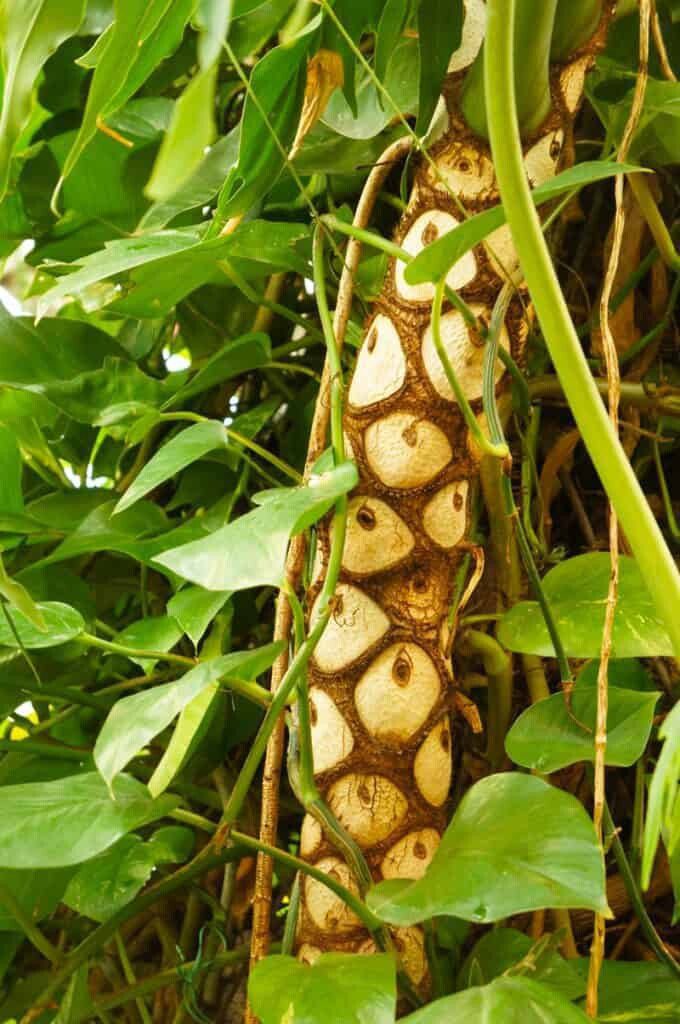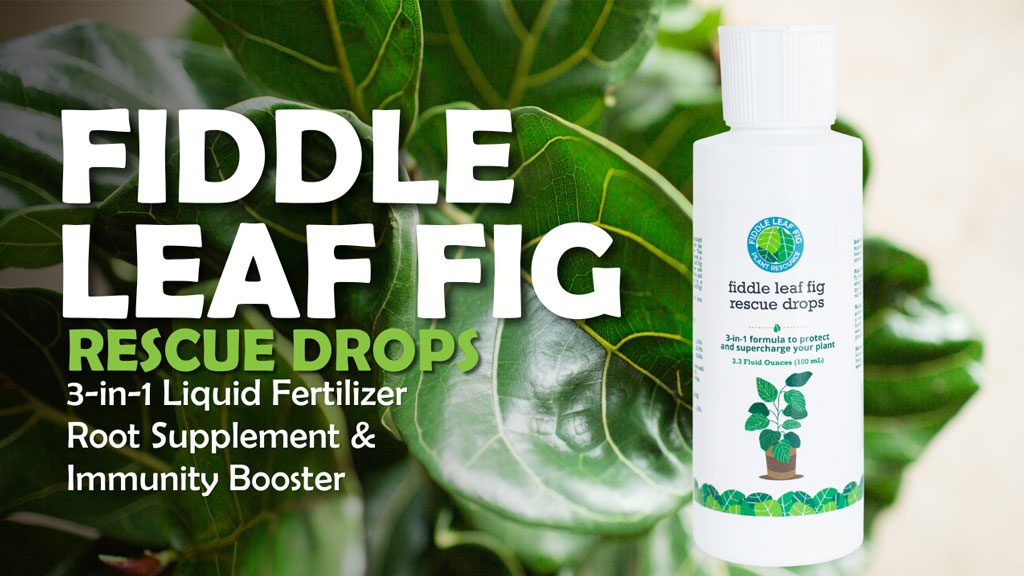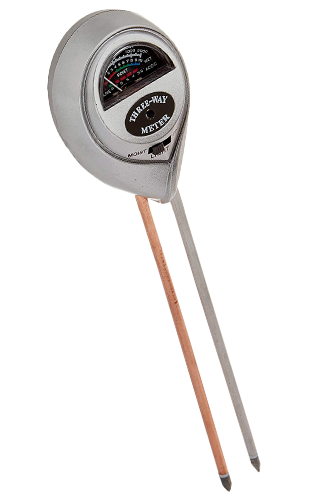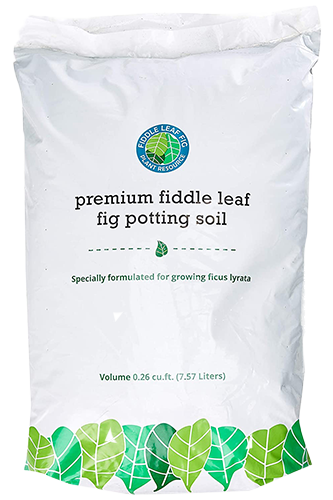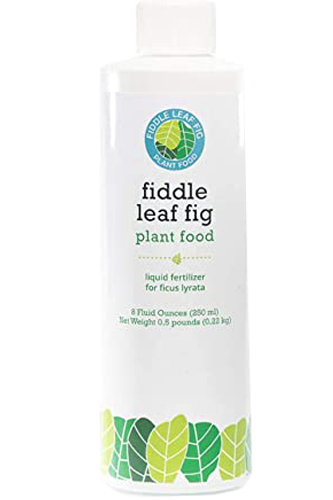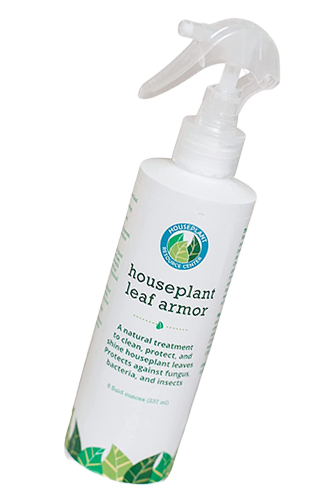Many wonder, “Are Fiddle Leaf Figs Poisonous to Cats, Dogs, or Other Pets?”
A big concern for a lot of fiddle leaf fig owners—or potential fiddle leaf fig owners—is their toxicity to cats, dogs, and humans.
The bad news: Yes, fiddles are toxic to pets like cats and dogs, and also to people.
When cut, fiddle leaf fig leaves, stems, and trunks emit an irritating white sap that you definitely don’t want on your skin or in your digestive system!
The good news is that fig trees are only mildly poisonous, and while they can cause illness and oral irritation, throat irritation, and abdominal pain, ingestion won’t lead to very serious illness or death. A fiddle’s sap can also irritate or even blister the skin. (This is why it’s important to wear gloves when pruning or propagating your fiddle!)
If you have pets who might take a bite out of your fiddle’s leaves, here’s what you need to know and what to do if a pet ingests any part of your fiddle or gets the sap on its skin.
Are Fiddle Leaf Figs Poisonous to Cats and Dogs?
In short, yes, every part of the plant is poisonous to cats and dogs. A ficus tree might not be the best houseplant choice if you have cats or dogs who might try to sample your plant’s leaves!
Fiddle leaf fig leaves and stems contain a thick white sap high in calcium oxalate crystals. These crystals have sharp edges that can irritate the mouth, throat, stomach, and intestinal tract when ingested and can irritate or even blister the skin if it makes contact and isn’t washed off immediately.
If you do have pets and a fiddle leaf fig, it’s important to prevent your pets from eating your plant (even small pieces) or getting the sap on their skin or in their eyes.
How Do Fiddle Leaf Figs Affect Cats and Dogs?
Are Fiddle Leaf Figs Poisonous to Cats, Dogs, or Other Pets?
So what happens if your cat or dog takes a bite out of your fiddle and gets the sap on its skin?
As soon as they take a bite, those calcium oxalate crystals are going to scratch and irritate the delicate tissues in their mouth, throat, and stomach. It won’t be pleasant!
If your cat or dog takes a nibble at your fiddle, you might notice symptoms like drooling; swelling of the mouth, tongue, or lips; vomiting; appetite loss; excessive or lessened urination; excessive or lessened thirst; or diarrhea. If your pet ate a lot of your fiddle, you might see breathing issues, blood pressure issues, and weakness or lethargy.
Cats may become dehydrated (vomiting can indicate dehydration as well as digestive distress) and either drink large amounts of water or very little to none at all.
Dogs will likely paw at their mouths as well and show signs of extreme or lessened thirst.
The severity of the reaction usually depends on the amount ingested. Symptoms can range from almost nothing or very mild (if your pet only took a tiny taste) to severe, like if your pet ate a whole leaf.
If your pet got the sap on its skin or in its eyes, you might notice redness, a rash, blistering, and your pet pawing or scratching at its skin or eyes.
If you notice any of these symptoms in your cat or dog and notice teeth or bite marks on your fiddle, contact your vet immediately.
Identify Symptoms in Cats and Dogs
If you notice signs that your fiddle has been fiddled with—teeth marks, bites, leaves missing, etc.—check on your pet and keep a close eye on them.
If they start pawing at their mouth or skin, biting or scratching excessively at themselves, if they stop eating or start vomiting or have diarrhea, contact your vet right away. Also check their skin for rashes or blisters that may signal that the sap has gotten on their skin.
Look at your fiddle and try to assess how much your pet has ingested and how long ago, because this will help your vet assess just how serious your pet’s condition might be and what steps to take next. We recommend talking to your vet before you do anything to treat your pet, because you don’t want to accidentally cause more harm than good.
Your vet will likely rinse the sap from your pet’s mouth and skin and, if a significant amount was ingested, they may also run tests to see if there’s possible damage to your pet’s organs.

Are Fiddle Leaf Figs Toxic to Other Pets?
Are Fiddle Leaf Figs Poisonous to Cats, Dogs, or Other Pets?
Yes, fiddles are toxic to other animals you might have as pets such as birds, rabbits, rats, hamsters, guinea pigs, ferrets, etc. Keep your fiddles out of reach of all pets if possible, or choose a different plant altogether.
Symptoms of poisoning from fiddle leaf figs are fairly similar for most pets. Watch for signs of skin irritation like excessive biting or scratching at the skin or eyes. Vomiting, diarrhea, and significant changes in eating and drinking habits are also consistent signs that something’s wrong.
How to Determine Plant Toxicity
Toxic plants are sorted into four categories, ranging from highly toxic to mildly toxic.
Toxicity Class 1
This signifies major toxicity that causes serious illness or death. Coming into contact with a Class 1 plant can cause you to go into a coma or have significant organ or liver damage.
Some examples of plants that fall into this category include (but are definitely not limited to) monkshood, belladonna, oleander, mistletoe, hemlock, etc. (Fun fact: Many of these plants have been used to create potent poisons for various purposes throughout history. Don’t mess with these! Many of these plants are as dangerous as they are beautiful.)
Toxicity Class 2
Class 2 is minor toxicity: It may cause a minor illness if ingested, resulting in vomiting or diarrhea.
Examples of plants in this category include alder, columbine, umbrella plant, juniper, and some species of snowdrop.
Toxicity Class 3
These plants typically contain high amounts of oxalates that can irritate the skin and internal digestive system.
Oxalates are the next class where the sap contains oxalate crystals, which can cause drooling and breathing difficulties if ingested. In this case, you would not want your dog, cat, or child ingesting any plant identified as Class 3.
While fiddle leaf fig sap does contain calcium oxalate crystals, it doesn’t contain such a high concentration of many plants included in this category.
Some examples of toxicity Class 3 plants include the arrowhead plant, calla lily, elephant ear, alocasia, philodendron, and monstera plants.
Toxicity Class 4
Dermatitis is identified in plants under Class 4 toxicity. Because these plants do contain some oxalates, lip and mouth irritation will be present if the plant is ingested, and it can cause skin irritation and rash if you have come in contact with the sap.
Fiddle leaf figs fall into this category, along with several other species of ficus (rubber tree and weeping fig, to name a few), ash, gingko, walnut, and plumeria.
Which Plants Are Toxic?
Some plants that are very poisonous are azaleas, mistletoe, hydrangea, several lily varieties, oleander, and rhododendron, to name a few.
Fiddle leaf philodendron or horsehead philodendron (philodendron bipennifolium) is poisonous and sometimes gets confused with ficus lyrata, or fiddle leaf figs, because of its name.
Many common houseplants are actually toxic, so it’s best to do your research before selecting your indoor plants, especially if you have curious cats, dogs, or children at home. You can find the 20 most toxic houseplants in this article by Ben Hilton where he explains each toxic substance and how they can affect humans and pets. So it’s best to do your research before selecting your indoor plants, especially if you have curious cats, dogs, or children at home. There are also plenty of beautiful, easy-to-care-for houseplants that are also easy to find. You could fill your whole home with lovely, non-toxic plants so you’ll never have to worry about your pets or kids accidentally ingesting them.
Fiddle Leaf Figs Are Toxicity Class 4
Fiddle leaf figs are in the Toxicity Class 4. This means that ingesting the plant won’t cause serious illness or death (unless it’s ingested in very large amounts).
Take care to keep your fiddle leaf fig away from your pets and children.
When you handle your plant, you want to take care not to come into contact with the sap, especially when pruning or propagating. If you need to prune, make sure to wear gloves, and it’s also a good idea to wipe up sap and/or put down a tarp, because the sap can also damage flooring.
Here are additional resources for you so you can take precautions with the plants you choose for your home to keep your pets and children safe:
Sometimes it’s just easier to choose non-toxic indoor plants to begin with!
Make Your Fiddle Leaf Fig Cat- and Dog-Friendly
The only way to make your fiddle leaf fig pet-friendly is to keep your pets out of it.
Usually this means putting a fiddle in a room your pets cannot access or up on a high shelf where your cat or dog can’t reach. (This might be hard to do with larger plants, but it’s a good option if you can pull it off.) Gating off your fiddle with furniture or baby gates can also work well with some pets, and elevated pots, stools, and plant stands can be an effective and aesthetically pleasing option!
Another good option is to repel your pets. Making your fiddle smell bad to your cat or dog is a great way to do this!
Cats, in particular, are repelled by the smell of citrus (dogs aren’t fans either), so you can put a little orange or lemon essential oil around the rim of the pot, or scatter some citrus peels on the surface of the soil. Lavender or rosemary oil on the rim of the pot can also work.
For dogs, try sprinkling pepper on the soil or soaking a few cotton balls in clove oil and placing them on top of the soil.
Don’t put any liquid repellant or essential oil directly into the soil, though, as that can lead to chemical burn on the roots!
You can also take steps to train your pet to stay away from your fiddle. This method takes a lot more work, but it can be extremely effective in the long run.
Keep a spray bottle nearby to squirt your pet if you catch them in the act, and make sure to give them exercise and provide them with other things to play with, chew on, and even dig in so they won’t be seeking additional entertainment from your fiddle leaf fig!
Providing alternatives doesn’t ALWAYS work (cats are notorious for turning up their noses at things we buy for them), but it can help!
You can also try “booby-trapping” your plants to teach your pets that there are negative consequences for fiddling. Try stacking some cans near the plant so that they’ll fall over and create a scary noise when your pet comes snooping. This method works particularly well for cats who tend to nibble on plants.
Cats may instinctively chew on plants to help their digestion, so try growing some plants that are safe (or even healthy) for them to eat. Catnip, wheatgrass, and mint work well. Put these plants in convenient places to make them more attractive than your fiddle!
Ensuring your pet gets a healthy, balanced diet that includes a little greenery can also discourage them from seeking nutrients elsewhere.
Keep experimenting with a combination of behavioral approaches (providing alternatives, training) and deterrents (citrus peels in the soil) to see what works for your plant, your home, and your pets.
You’ll find something that works!
Knowledge Is Power
Fiddle leaf figs are beautiful and look stunning in any space, but they do pose a problem if you have cats, dogs, or other pets that like to snack on houseplant leaves! We answered the question “Are Fiddle Leaf Figs Poisonous to Cats, Dogs, or Other Pets?”
It might be easier to choose a different plant altogether, but if you simply MUST have a fiddle (and we don’t blame you one bit!), it’s important to be aware of the risks as well as the signs and symptoms to watch out for in case your pet does eat a bit of your fiddle or get the sap on its skin. And it always helps to know a few simple tricks for keeping your pets away from your plant!
To learn more:
- Sign up for our free Fiddle Leaf Fig Care 101 Webinar or our free Fiddle Leaf Fig Course, and make sure you’re subscribed to our newsletter.
- Download our free Propagation Guide
- Read The Fiddle Leaf Fig Expert, your complete guide to growing healthy fiddle leaf fig plants. The book is available in full-color paperback or Kindle edition on Amazon now.
Grab the Essentials for Your Fiddle Leaf Fig:
- Premium Fiddle Leaf Fig Potting Soil
- Fiddle Leaf Fig Plant Food
- Root Rot Treatment
- Houseplant Leaf Armor to protect against insects, bacteria, and fungus (As an added bonus, it also cleans and adds shine to your plant’s leaves!)
- Moisture meter to always know when your plant is thirsty.
- Houseplant Propagation Promoter to propagate more quickly and with more success.

